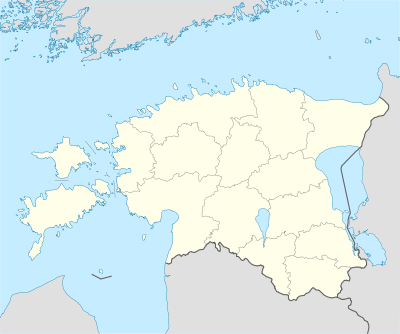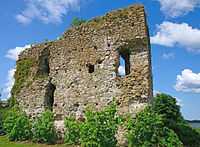Vasknarva
| Vasknarva | |
|---|---|
| Village | |
|
| |
 Vasknarva Location in Estonia | |
| Coordinates: 58°59′58″N 27°44′19″E / 58.99944°N 27.73861°ECoordinates: 58°59′58″N 27°44′19″E / 58.99944°N 27.73861°E | |
| Country |
|
| County |
|
| Municipality |
|
| Population (2000) | |
| • Total | 59 |
Vasknarva (Russian: Сыренец, Syrenets; German: Nyslott, Neuschloss) is a village in Alajõe Parish, Ida-Viru County in northeastern Estonia. It is located on the northern shore of Lake Peipus, in the headwaters of Narva River. Vasknarva has a population of 59 (as of 2000), most of them are Old Believers.

The village sprung up in 14th century just next to Vasknarva order castle (Neuschloss) on the northeastern border of Old Livonia. The first castle was founded in 1349. 1427–1442 a new castle (Vastne-Narva) was built, which became the centre of the vogtei of the Livonian Order. The castle was wracked in the Livonian War. Until the Great Northern War it was a fort of great importance, commanding the mouth of the Narva River. It has been known in Russian chronicles either as Syrensk or Syrenets. Local lore has it that St. Olga of Pskov narrowly escaped drowning when crossing the Narva rapids at Syrenets. Nowadays only parts of 3 meters thin walls have survived, mainly on the northern side.
The name translates from Estonian as "Copper Narva". According to etymology it derived from the copper roof of the castle.
Nowadays there is a small boat harbour, border guard cordon, nunnery and St. Elijah Orthodox church. By its architecture Vasknarva is a common Peipsi Russian street village where 1-storey wooden buildings are situated side by side just beside the street.
On the other bank of Narva River there is Russian Skamya village.
American literary scientist Temira Pachmuss was born in Vasknarva.
Gallery
- Vasknarva castle
See also
External links
- Vasknarva Castle at Estonian Manors Portal (Estonian)
 |
Jaama (Illuka Parish) |  | ||
| Smolnitsa | |
Narva River / Skamya (Russia) | ||
| ||||
| | ||||
| Lake Peipus |
| ||||||||




